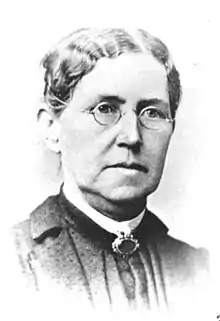Mary C. Jacobs | |
|---|---|
 | |
| Born | Mary Catherine Goslin February 1, 1828 |
| Died | November 14, 1909 (aged 81) |
| Other names | M. C. Jacobs |
| Occupation(s) | farmer, author |
| Known for | The Pony Engine |
| Spouses | Alanson Dickerson
(m. 1846; died 1851)Nathaniel Ross Jacobs
(m. 1855; died 1870)T. K. Jacobs
(m. 1881; died 1884) |
| Children | 4 |
Mary Catherine Goslin Jacobs (February 1, 1828 - November 14, 1909) was an American horticulturalist and author, known for her story The Pony Engine, an early published version of The Little Engine that Could.
The Pony Engine
The Pony Engine was a short story that appeared in the periodical Kindergarten Review in 1910.[1] Jacobs' story had a footnote claiming "an illustration given in a lecture served as a basis for this little story."[2] It was circulated widely in newspapers of the time, and versions of her story were performed in school performances.[3][4][5]
In 1956 Arnold Munk, a New York publisher, offered prizes for people who could help him trace the origins of The Little Engine That Could.[6] Arnold Munk was better known as Watty Piper who wrote the best-known version of the story. Mrs. Ruth L. Arthur, a school librarian from Philadelphia, won first prize for sending in a copy of Mrs. Jacobs' published version of the story.[6][7]
Farming and horticulture
Jacobs was married three times, first to Alanson Dickerson (1811-1851) in 1846 and then later to Nathaniel Ross Jacobs (1822 - 1870) in 1855.[8] She had four children, two from her first marriage and two, Gertrude and Lily, from her second marriage.[9] When Jacobs died when she was forty-two, he left her deeply in debt.[10] She was allowed to keep one-third of the family's land and thirty dollars (approximately $600 in 2021).
Over ten years she got herself out of debt and became a successful farmer, growing peaches, strawberries, and grapes, and selling dressed poultry and raising a herd of Alderney cattle. She married T. K. Jacobs in May of 1881, but he died in November 1884.[10][11] She and her grown daughter who lived with her were both known as "well-read well-informed people" and both wrote poetry.[10] She wrote several textbooks on farming.[12]
Jacobs sided with the Confederates in the Civil War. Originally a Methodist, the she left the church when it sided with the abolitionists and joined the Episcopal Church. She sponsored an orphanage in Wilmington, Delaware and was said to have raised four of her own children and 28 other children.[12]
Early life
Mary Catherine Goslin was born in 1828 to Hester (née Cannon) and John Goslin at Cannon's Ferry near Woodland, Delaware.[10] The family moved to Bridgeville, Delaware when she was twelve.[10]
References
- ↑ "Watty Piper – The Man Behind the Little Engine". Toby The Big Little Tugboat. 2020-04-14. Retrieved 2021-05-14.
- ↑ "Kindergarten review. v.21 1910-1911". HathiTrust. 2020-12-05. hdl:2027/osu.32435057727273. Retrieved 2021-05-14.
- ↑ "GRAFTON". Grand Forks Herald. November 22, 1912. Retrieved 14 May 2021.
- ↑ "The Pony Engine". The Presbyterian of the South. Atlanta, Georgia. November 18, 1914. p. 5. Retrieved 14 May 2021.
- ↑ "The Pony Engine". The Catholic bulletin. St. Paul Minnesota. January 21, 1911. p. 7. Retrieved 14 May 2021.
- 1 2 Nichols, Harmon (April 15, 1956). "Nursery Rhymes Have Changed". The Ledger & Times. Retrieved 14 May 2021.
- ↑ "Little Engine Subject of Hunt". The Fairbury Daily News. Fairbury, Nebraska. Associated Press. October 6, 1955. p. 1. Retrieved 14 May 2021.
- ↑ Marriages D 1680-1850. "Delaware Vital Record Index Cards, 1680-1934". FamilySearch. Retrieved 14 May 2021.
{{cite web}}: CS1 maint: numeric names: authors list (link) - ↑ Jacobs, Nathaniel. "1870 US Census". FamilySearch. Retrieved 14 May 2021.
- 1 2 3 4 5 Scharf, John Thomas (2020-06-10). "History of Delaware. 1609-1888". Internet Archive. Retrieved 2021-05-14.
- ↑ "Thomas K. Jacobs". The Lima News. 2020-04-07. Retrieved 2021-05-14.
- 1 2 "Death Takes Noted Woman". The Evening Journal. Wilmington Delaware. November 22, 1909. p. 7. Retrieved 14 May 2021.
External links
- The Pony Engine, in Kindergarten Review (1910, from Hathi Trust)